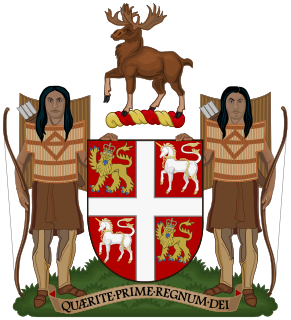The Provincial Secretary was a senior position in the executive councils of British North America's colonial governments, and was retained by the Canadian provincial governments for at least a century after Canadian Confederation was proclaimed in 1867. The position has been abolished in almost all provinces in recent decades (Quebec in 1970, Ontario 1985, most recently by British Columbia in 2000); the exceptions are Saskatchewan and Nova Scotia, [1] where it still exists but is no longer a senior portfolio.
An Executive Council in Commonwealth constitutional practice based on the Westminster system is a constitutional organ which exercises executive power and (notionally) advises the governor or governor-general. Executive Councils often make decisions via Orders in Council.

The term "British North America" refers to the former territories of the British Empire in North America, not including the Caribbean. The term was first used informally in 1783, but it was uncommon before the Report on the Affairs of British North America (1839), called the Durham Report. These territories today form modern-day Canada and the Pacific Northwest of the United States.

In history, a colony is a territory under the immediate complete political control and occupied by settlers of a state, distinct from the home territory of the sovereign. For colonies in antiquity, city-states would often found their own colonies. Some colonies were historically countries, while others were territories without definite statehood from their inception.
Contents
The position existed prior to Confederation in the Province of Canada (as well as in the previous provinces of Upper Canada and Lower Canada) and the various governments in Atlantic Canada under British rule, though in Newfoundland and Prince Edward Island the title was Colonial Secretary. British Columbia also had a Colonial Secretary prior to becoming a province of Canada in 1871. Before the granting of responsible government and the emergence of the position of Premier, the Provincial Secretary was the leading position in the executive councils appointed by the various governors and lieutenant-governors of British North America. Frequently, Provincial Secretaries during these periods were the most powerful elected representatives in their jurisdictions.

The Province of Canada was a British colony in North America from 1841 to 1867. Its formation reflected recommendations made by John Lambton, 1st Earl of Durham in the Report on the Affairs of British North America following the Rebellions of 1837–1838.

The Province of Upper Canada was a part of British Canada established in 1791 by the Kingdom of Great Britain, to govern the central third of the lands in British North America, formerly part of the Province of Quebec since 1763. Upper Canada included all of modern-day Southern Ontario and all those areas of Northern Ontario in the Pays d'en Haut which had formed part of New France, essentially the watersheds of the Ottawa River or Lakes Huron and Superior, excluding any lands within the watershed of Hudson Bay. The "upper" prefix in the name reflects its geographic position along the Great Lakes, mostly above the headwaters of the Saint Lawrence River, contrasted with Lower Canada to the northeast.

The Province of Lower Canada was a British colony on the lower Saint Lawrence River and the shores of the Gulf of Saint Lawrence (1791–1841). It covered the southern portion of the current Province of Quebec and the Labrador region of the current Province of Newfoundland and Labrador.
The Provincial Secretary was the equivalent of the former Canadian Cabinet position of Secretary of State for Canada. Like its federal counterpart it included an eclectic variety of responsibilities that were not assigned to other ministers, most of which would eventually evolve into portfolios of their own. In Nova Scotia, where the position originated in 1720, the Provincial Secretary was also the treasurer of the province until 1946. The provincial secretary was also responsible for official communications between the provincial government and the Colonial Office in London as well as with other provincial and colonial governments (and after 1867 the federal government). As well, the position also included various duties related to ceremonial occasions, visits by dignitaries, protocol, relations between the government and the office of lieutenant-governor and commemorative events particularly in relation to the monarchy.
The Secretary of State for Canada was a Canadian Cabinet position with a corresponding department. It was established in 1867 as the official channel of communication between Canada and the Imperial government in London. As Canada became increasingly independent after World War I and particularly with the passage of the Statute of Westminster in 1931 this role fell into disuse.

Nova Scotia is one of Canada's three Maritime Provinces, and one of the four provinces that form Atlantic Canada. Its provincial capital is Halifax. Nova Scotia is the second-smallest of Canada's ten provinces, with an area of 55,284 square kilometres (21,300 sq mi), including Cape Breton and another 3,800 coastal islands. As of 2016, the population was 923,598. Nova Scotia is Canada's second-most-densely populated province, after Prince Edward Island, with 17.4 inhabitants per square kilometre (45/sq mi).

A treasurer is the person responsible for running the treasury of an organization. The significant core functions of a corporate treasurer include cash and liquidity management, risk management, and corporate finance.
Generally, the Provincial Secretary acted as a province's Registrar-General and was responsible for formal documents and records such as licences, birth and death certificates, land registries and surveys, business registrations and writs. As well, the position was generally responsible for the administration of the civil service and of elections. Provincial secretaries were usually the most senior member of the provincial cabinet outside of the Premier, and the office holder was often designated as Acting Premier when the Premier was out of province, ill or otherwise unavailable.
The position of Provincial Secretary was particularly important in Manitoba from 1870 to 1874, as that province's institutions were being established. The province had no Premier during this period, and its Lieutenant-Governors acted as the de facto leaders of government. The early Provincial Secretaries (including Alfred Boyd and Henry Joseph Clarke) were the most prominent elected officials in the province, and are retroactively regarded as Premiers in many modern sources.

Manitoba is a province at the longitudinal centre of Canada. It is often considered one of the three prairie provinces and is Canada's fifth-most populous province with its estimated 1.3 million people. Manitoba covers 649,950 square kilometres (250,900 sq mi) with a widely varied landscape, stretching from the northern oceanic coastline to the southern border with the United States. The province is bordered by the provinces of Ontario to the east and Saskatchewan to the west, the territories of Nunavut to the north, and Northwest Territories to the northwest, and the U.S. states of North Dakota and Minnesota to the south.

Alfred Boyd was a politician in Manitoba, Canada. He is usually considered to have been the first Premier of Manitoba (1870–1871), but he was not recognized by that title at the time and was not the real leader of the government. He is more correctly referred to as the first Provincial Secretary of Manitoba.

Henry Joseph Clarke, who sometimes used the middle names Hynes and O'Connell, was a lawyer and politician in Manitoba, Canada.
The Provincial Secretary continued to oversee miscellaneous government activities into the twentieth-century (Nova Scotia's Public Service Act conferred to the position responsibility for all matters not specifically assigned to any other minister). Frequently, twentieth-century Provincial Secretaries would concurrently hold other cabinet portfolios.









